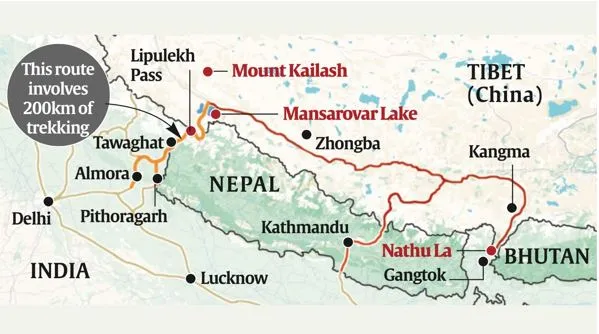

21st April 2025 (15 Topics)
Context
The Ministry of External Affairs (MEA) of India has announced that the Kailash Mansarovar Yatra will resume in 2025, after a four-year suspension. The Yatra was halted in 2020, initially due to the COVID-19 pandemic, but later extended due to serious border tensions between the two countries — especially after the deadly Galwan Valley clash in June 2020.
What is the Kailash Mansarovar Yatra?
- The Kailash Mansarovar Yatra is a spiritual pilgrimage undertaken by people of multiple faiths — primarily Hindus, but also Buddhists, Jains, and followers of the Tibetan Bon tradition.
- It involves traveling to two sacred sites in Tibet’s Ngari Prefecture (now part of the Tibet Autonomous Region, China):
- Mount Kailash (6,638 meters): Mount Kailash is considered the celestial home of Lord Shiva and Goddess Parvati. It is believed that Lord Shiva meditates on the mountain's summit.
- Height: 21,778 feet (6,714 meters), located in Tibet at the center of the Himalayas.
- Significance for different religion:
- Buddhism: Mount Kailash is revered as the home of the Buddha Demchok.
- Jainism: Mount Kailash is considered the site of spiritual enlightenment for Rishabhanatha, the first Tirthankara (spiritual leader).
- The mountain is also described as the cosmic axis (or Mount Meru) connecting heaven and earth in Tibetan Buddhism.
- Lake Mansarovar (4,600 meters): It is a sacred lake situated at the foot of Mount Kailash, it holds a special place in Hinduism, Buddhism, and Jainism. According to Hindu belief, the lake was first visualized by Lord Brahma and later materialized on Earth.
- It is said that Goddess Sati's hands fell near the lake, making it one of her 51 Shaktipeeths (sacred spots).
- Pilgrims not only visit the lake but also undertake a ‘parikrama’ (circumambulation) of Mount Kailash, a deeply symbolic act believed to wash away sins and bring blessings.
- Key-Routes: There are three main routes used by Indian pilgrims:
- Lipulekh Pass Route (via Uttarakhand): It is the shortest path to Tibet border. It requires around 200 km of high-altitude trekking. It is the most traditional route (operational since the 1980s).
- Nathu La Route (via Sikkim): Fully motorable till the lake (only trekking required for Mount Kailash circuit). It is longer route, but physically easier. It opened in 2015 for pilgrims who may not be fit for trekking.
- Nepal Route (via Kathmandu or Nepalgunj): It is operated by private tour operators. Often more expensive, and subject to Chinese visa and permit rules. Sometimes includes aerial ‘darshan’ flights for those unable to travel by land.

More Articles

